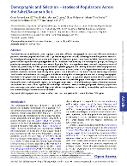Demographic and Selection Histories of Populations Across the Sahel/Savannah Belt

Autor
Fortes-Lima, Cesar
Triska, Petr
Cizkova, Martina
Datum vydání
2022Publikováno v
Molecular Biology and EvolutionRočník / Číslo vydání
39 (10)ISBN / ISSN
ISSN: 0737-4038Metadata
Zobrazit celý záznamKolekce
Tato publikace má vydavatelskou verzi s DOI 10.1093/molbev/msac209
Abstrakt
The Sahel/Savannah belt harbors diverse populations with different demographic histories and different subsistence patterns. However, populations from this large African region are notably under-represented in genomic research. To investigate the population structure and adaptation history of populations from the Sahel/Savannah space, we generated dense genome-wide genotype data of 327 individuals-comprising 14 ethnolinguistic groups, including 10 previously unsampled populations. Our results highlight fine-scale population structure and complex patterns of admixture, particularly in Fulani groups and Arabic-speaking populations. Among all studied Sahelian populations, only the Rashaayda Arabic-speaking population from eastern Sudan shows a lack of gene flow from African groups, which is consistent with the short history of this population in the African continent. They are recent migrants from Saudi Arabia with evidence of strong genetic isolation during the last few generations and a strong demographic bottleneck. This population also presents a strong selection signal in a genomic region around the CNR1 gene associated with substance dependence and chronic stress. In Western Sahelian populations, signatures of selection were detected in several other genetic regions, including pathways associated with lactase persistence, immune response, and malaria resistance. Taken together, these findings refine our current knowledge of genetic diversity, population structure, migration, admixture and adaptation of human populations in the Sahel/Savannah belt and contribute to our understanding of human history and health.
Klíčová slova
Africa, population structure, admixture, selection, pastoralists, camel herders, CNR1 gene
Trvalý odkaz
https://hdl.handle.net/20.500.14178/1904Licence
Licence pro užití plného textu výsledku: Creative Commons Uveďte původ-Neužívejte dílo komerčně-Nezpracovávejte 4.0 International






